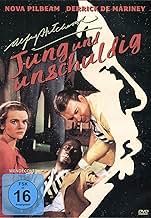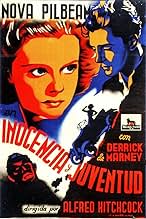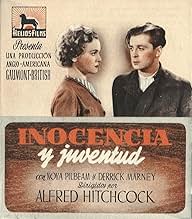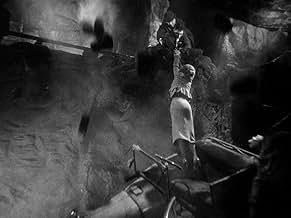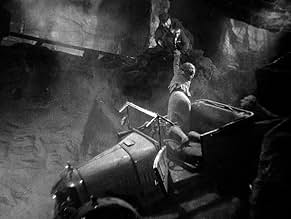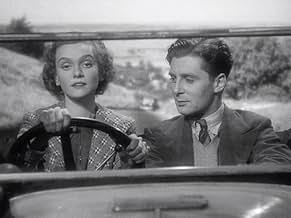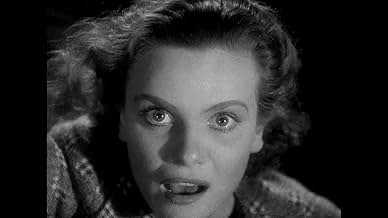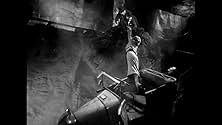CALIFICACIÓN DE IMDb
6.8/10
12 k
TU CALIFICACIÓN
Un hombre se da a la fuga al ser acusado de asesinato y pone en riesgo a una bella desconocida por su causa.Un hombre se da a la fuga al ser acusado de asesinato y pone en riesgo a una bella desconocida por su causa.Un hombre se da a la fuga al ser acusado de asesinato y pone en riesgo a una bella desconocida por su causa.
- Dirección
- Guionistas
- Elenco
- Premios
- 1 premio ganado en total
Derrick De Marney
- Robert Tisdall
- (as Derrick de Marney)
Frank Atkinson
- Petrol Pump Attendant
- (sin créditos)
Clive Baxter
- Burgoyne Boy
- (sin créditos)
Pamela Bevan
- Little Girl at Party
- (sin créditos)
Ernest Borrow
- Policeman Outside Courtroom
- (sin créditos)
Opiniones destacadas
Another wrongfully-accused-man-on-the-run tale from Hitchcock, this time starring Derrick De Marney as a singer accused of murder. He escapes custody with hopes of clearing his name, and gets some unexpected help from Erica (Nova Pilbeam), the daughter of a police inspector. With Percy Marmont, John Longden, Edward Rigby, Mary Clare, Basil Radford, George Curzon, George Merritt, Bill Shine, and Torin Thatcher.
This was becoming well-trod territory for Hitchcock even back in '37, and De Marney & Pilbeam don't quite have the screen charisma of Donat & Carroll, but this is still enjoyable if one keeps their expectations in check. There's some miniature work featuring some trains and cars, and suspenseful mine collapse. The finale, with a band in blackface, may keep this one on the lesser-shown list. Pilbeam was 17 when this was filmed, while her romantic onscreen partner De Marney was 31.
This was becoming well-trod territory for Hitchcock even back in '37, and De Marney & Pilbeam don't quite have the screen charisma of Donat & Carroll, but this is still enjoyable if one keeps their expectations in check. There's some miniature work featuring some trains and cars, and suspenseful mine collapse. The finale, with a band in blackface, may keep this one on the lesser-shown list. Pilbeam was 17 when this was filmed, while her romantic onscreen partner De Marney was 31.
Hitchcock is in a class by himself. I'll give any of his films multiple viewings. The story and structure of "Young and Innocent" resemble "The 39 Steps," with a young woman helping a young man on the run thwart the police and prove his innocence. This film is a standout, though, not because of the story or acting (both charming), but because of a virtuoso bit of directing by the Master, in which the location of the killer is revealed. As I watched the scene unfold for the first time, I remember thinking, "This is what makes Hitchcock Hitchcock." I wish I had never seen any Hitchcock films so I could watch them all again for the first time. His is a brilliant body of work, and this is an often overlooked example of his mastery of the film art.
This is a good Hitchcock film, but on the lighter side. The acting may be disputed (certainly many dispute about it!), but in my opinion it is a very solid, entertaining, and well-acted picture. It does have much of Hitchcock about it (not surprisingly) and is well worth watching. All of the classic Hitchcock elements are there, and they fit together wonderfully: the musical score, the camera work, the twists and turns in the plot, the thrilling scenes, the build-up, the director himself ... and not to forget the story! This is built up very carefully, and contains many, many interesting side-glances and elements. But one needs to watch the film very carefully, or more than once, in order to find these. It is indeed a sort of '39 Steps', and a precursor to several later Hitchcock films, but in its own way it occupies a place rather different than any other Hitchcock film. I am referring to a certain 'bucolic' atmosphere, which is perhaps only equalled by 'The Trouble With Harry'. The parallels to this film have perhaps not yet been adequately explored.
Aside from the suspense, there are several notable scenes. Two minutes into things, and a man opens a front door. Suddenly facing us just beyond the railing is a roiling wall of water, an angry sea about to pour over us. I grabbed my seat cushion, hoping it would float. Then there's the flop house full of snoring vagrants, dead cockroaches, and peeling paint. Right away, I reached past my highball glass and took the wife's Coke. Topping that, is the drive into the mine tunnel. It's a marvel of special effects and timing, with an effect as stunning, I believe, as anything in today's digitally drenched cinema. Nonetheless, I checked the garage to make sure my car was still on all fours. The final scene was a contrast since I'd just watched a 40's musical with wild-man drummer Gene Krupa. Here, it's like watching a wind-up toy slowly losing its mind.
Nova Pilbeam is not exactly a glamor girl, with her over-sized brow and snub nose; still and all, for an 18 -year old she's one heck of an actress. This is a pretty slender exercise for Hitchcock, nothing terribly profound and a lot like The Thirty-Nine steps of two years before. Too bad De Marney doesn't generate the kind of charisma or sympathy the Robert Donat part calls for. Hitchcock was to plow this furrow of racing against the law a number of times. Here, it's Pilbeam going against her civic duty and constable father to help prove accused murderer De Marney's innocence. Their bond of trust grows over time, showing once more that young love often sees what the law cannot-- at least as far as the movies are concerned.
This may not be top-flight Hitchcock. Still, there are the usual humorous touches, darkly suggestive moments, and imaginative moves with the camera. So if you've got a spare hour and half, see why England should never have allowed that funny looking, fat guy an exit visa.
Nova Pilbeam is not exactly a glamor girl, with her over-sized brow and snub nose; still and all, for an 18 -year old she's one heck of an actress. This is a pretty slender exercise for Hitchcock, nothing terribly profound and a lot like The Thirty-Nine steps of two years before. Too bad De Marney doesn't generate the kind of charisma or sympathy the Robert Donat part calls for. Hitchcock was to plow this furrow of racing against the law a number of times. Here, it's Pilbeam going against her civic duty and constable father to help prove accused murderer De Marney's innocence. Their bond of trust grows over time, showing once more that young love often sees what the law cannot-- at least as far as the movies are concerned.
This may not be top-flight Hitchcock. Still, there are the usual humorous touches, darkly suggestive moments, and imaginative moves with the camera. So if you've got a spare hour and half, see why England should never have allowed that funny looking, fat guy an exit visa.
Sort of a blueprint for any number of later, more bloated Hitchcocks: The man falsely accused of murder; the sympathetic miss who helps him, the set pieces in creepy places. This one has a lighter, more picaresque feel than most of the Master's movies, with irrelevant but diverting supporting characters, Maguffins, an unstarry cast, and an unusual dollop of humor. It's also blessed by a screenplay that leaps nimbly from improbability to improbability, as much as its more famous contemporaries, like "The 39 Steps" or "The Lady Vanishes."
The light tone throughout tips us off that everything's going to turn out all right, so there's less suspense than we associate with Hitchcock. Still, it's beautifully photographed (with one really stunning crane shot), beautifully paced, and enjoyably acted. The unstoried Nova Pilbeam is a standout: She's the ideal Hitchcock heroine, blonde, slender, and spirited.
The light tone throughout tips us off that everything's going to turn out all right, so there's less suspense than we associate with Hitchcock. Still, it's beautifully photographed (with one really stunning crane shot), beautifully paced, and enjoyably acted. The unstoried Nova Pilbeam is a standout: She's the ideal Hitchcock heroine, blonde, slender, and spirited.
¿Sabías que…?
- TriviaAlfred Hitchcock: Outside the courthouse holding a camera as Robert Tisdall (Derrick De Marney) escapes (at about 0:16:10).
- Errores(at around 50 mins) When Erica Burgoyne and Robert Tisdall have taken refuge at night in a small town by parking her car next to a siding just before where the railroad underpasses a bridge, the entire scene has been staged and shot as an obvious miniature as revealed by three mistakes:
- the somewhat jerky motion and unnatural lighting of an automobile (indicating that it was pulled) as it moves across the bridge above the railroad
- the express train speeding under the bridge drags a length of cord behind it as it disappears from view
- the camera tracking in closer to the parked automobile hidden in the shelter of freight trains on sidings reveals that the figures of Erica and Robert are actually modeled and painted figurines, motionless until the shot suddenly changes to a medium closeup shot of the two actors.
- Citas
[last lines]
Erica Burgoyne: Father, don't you think we ought to ask Mr. Tisdall to dinner?
- ConexionesFeatured in Reputations: Hitch: Alfred the Great (1999)
- Bandas sonorasNo One Can Like the Drummer Man
(uncredited)
Written by Samuel Lerner (as Lerner), Al Goodhart (as Goodhart) and Al Hoffman (as Hoffman)
Selecciones populares
Inicia sesión para calificar y agrega a la lista de videos para obtener recomendaciones personalizadas
Detalles
Taquilla
- Total a nivel mundial
- USD 401
- Tiempo de ejecución1 hora 20 minutos
- Color
- Relación de aspecto
- 1.37 : 1
Contribuir a esta página
Sugiere una edición o agrega el contenido que falta

